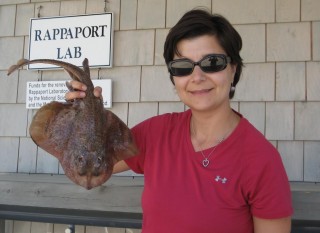Fish Colon Offers Insight Into Evolution

Nicole Theodosiou uses these skates, cartilaginous fish related to sharks and rays, to learn how we came to have colons.
“I’m particularly interested in how land animals stay hydrated, even though we don’t have a hard shell that prevents us drying up like raisins in the sun,” she said. “The colon is an important organ that helps us retain and absorb water, but how exactly did we come to have this organ?
The skate has begun to provide an answer.
As a marine creature that hasn’t changed in 450 million years, the skate is a living fossil that provides a snapshot of what animals were like a very long time ago. It’s also a fish that’s isotonic with its environment, meaning concentrations of things like salt inside its body are in exact balance with concentrations outside its body (in the ocean it lives in).
As a result, the skate is never thirsty or in danger of not getting enough to drink. But – intriguingly – it does have a rudimentary colon that soaks up water, as Theodosiou and her colleagues learned.
“Fish aren’t supposed to have the ability to absorb water in their intestines, they don’t really need to,” she explained. “The fact that skates do absorb water, and have the cell types and water channels to facilitate water absorption, means that animals were potentially ‘primed,’ in a way, to survive on land.”
“That’s new,” Theodosiou continued. “People think that animals move to a new environment and they evolve to survive. But maybe sometimes in evolution you need to be ready to accept the change that comes.”
Contact Information
Phillip Wajda
Director of Media Relations
wajdap@union.edu
Phone: 518-388-8394
Mobile: 518-857-8601
Media Contact
All latest news from the category: Life Sciences and Chemistry
Articles and reports from the Life Sciences and chemistry area deal with applied and basic research into modern biology, chemistry and human medicine.
Valuable information can be found on a range of life sciences fields including bacteriology, biochemistry, bionics, bioinformatics, biophysics, biotechnology, genetics, geobotany, human biology, marine biology, microbiology, molecular biology, cellular biology, zoology, bioinorganic chemistry, microchemistry and environmental chemistry.
Newest articles

Properties of new materials for microchips
… can now be measured well. Reseachers of Delft University of Technology demonstrated measuring performance properties of ultrathin silicon membranes. Making ever smaller and more powerful chips requires new ultrathin…

Floating solar’s potential
… to support sustainable development by addressing climate, water, and energy goals holistically. A new study published this week in Nature Energy raises the potential for floating solar photovoltaics (FPV)…

Skyrmions move at record speeds
… a step towards the computing of the future. An international research team led by scientists from the CNRS1 has discovered that the magnetic nanobubbles2 known as skyrmions can be…





















